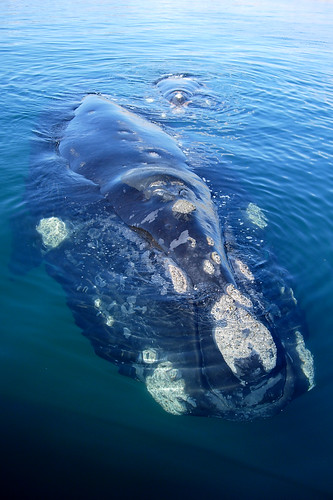Scientific Name: Eubalaena australis
Other Names: Black Right Whale, Right Whale
Officially, there are three varieties of Right Whale. In addition to the Southern Right, the there is the Eubalaena japonica, also known as the North Pacific Right Whale and the Eubalaena glacialis, or the Northern Right Whale. The Southern Right Whale has considerably higher population numbers than its Northern counterpart, of which there are only a few hundred individuals left.
Physical Characteristics
The Southern Right Whale has a very robust, rounded body that is, for the most part black or very dark brown. There are often white patches on the belly (nearer to the tail) and there may also be a mottling of slightly lighter colours on the remainder of the body. Its chin is particularly dark.
The Right Whales have very distinctively arched mouths and characteristic callosities on the top of the head, behind the eye, on the tip of the chin (on the skull, not the lip) and on the tip of the rostrum.

Southern Right Whale on the surface.
Southern Rights have no dorsal fin at all. Their pectoral fins are large and rounded. The tail fin is also fairly large with a very clear central notch and smooth trailing edges.
Adults reach an average length of between 11 and 18 metres and weigh 30 to 80 tonnes.
Behaviour
Rights Whales are big and bulky. Therefore, it may come as a surprise that they are rather playful and active. They are often seen breaching and lobtailing and even performing head stands, where they push their tails out of the water (while their heads are thrust far below the surface) and wave them in the air for up to two minutes.
They are slow swimmers and keenly playful. They have been known to investigate and bump foreign objects that are in the water, even pushing them in a teasing way.
Southern Right Whales usually travel in groups of two or three individuals. But, pod numbers can go right up to 12 animals or more where there is plenty of food.
Where to Find Them
Southern Right Whales are found in the Southern Hemisphere, around the coasts of Australia, South Africa, New Zealand and South America.
Diet
Right Whales feed by means of dense baleen plates, which sieve the ocean water that is sucked into the mouth, trapping tiny krill (crustaceans) in the fine hair-like structures.
Threats
The threats that face the Southern Right Whale are multi-faceted. This huge whale is sometimes caught in fishing nets, which prevent it from getting to the surface for air, effectively drowning the animal. Human disturbance, in the form of urbanisation, too many boats in their natural habitat and so on, as well as the destruction of their habitat are also major factors to the declining numbers of the magnificent Southern Right Whale.

